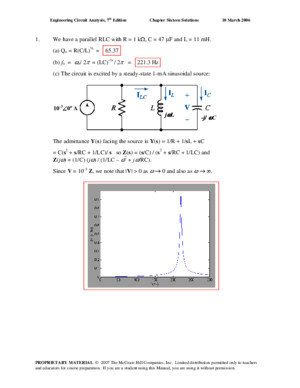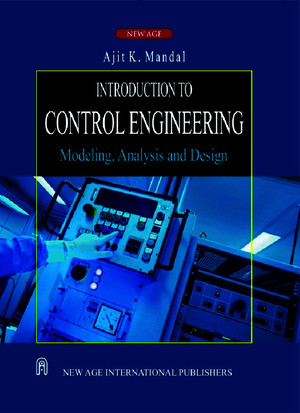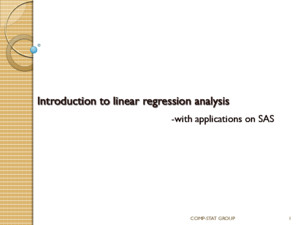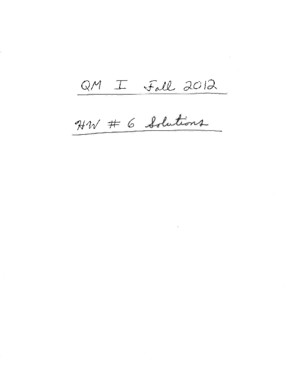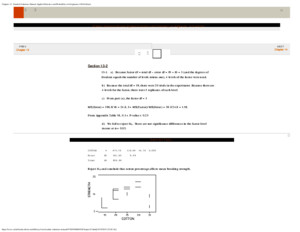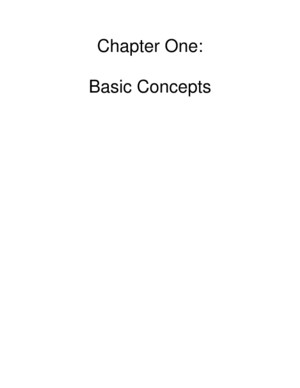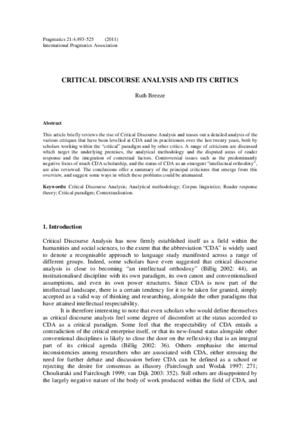Chapter 16 Solutions to Exercises - Circuit Analysis and Design
There is document - Chapter 16 Solutions to Exercises - Circuit Analysis and Design available here for reading and downloading. Use the download button below or simple online reader.
The file extension - PDF and ranks to the Documents category.
Tags
Related
Comments
Log in to leave a message!
Description
Download Chapter 16 Solutions to Exercises - Circuit Analysis and Design
Transcripts
Engineering Circuit Analysis, 7 th Edition Chapter Sixteen Solutions 10 March 2006 1 We have a parallel RLC with R = 1 k Ω , C = 47 μ F and L = 11 mH (a) Q o = R(C/L) ½ = 6537 (b) f o = ω o / 2 π = (LC) -½ / 2 π = 2213 Hz (c) The circuit is excited by a steady-state 1-mA sinusoidal source: 10 -3 0 o A j L -j/ C The admittance Y ( s ) facing the source is Y ( s ) = 1/R + 1/ s L + s C = C( s 2 + s /RC + 1/LC)/ s so Z ( s ) = ( s /C) / ( s 2 + s /RC + 1/LC) and Z ( j ω ) = (1/C) ( j ω ) / (1/LC – ω 2 + j ω /RC) Since V = 10 -3 Z , we note that | V | > 0 as ω → 0 and also as ω → ∞ PROPRIETARY MATERIAL © 2007 The McGraw-Hill Companies, Inc Limited distribution permitted only to teachers and educators for course preparation If you are a student using this Manual, you are using it without permission Engineering Circuit Analysis, 7 th Edition Chapter Sixteen Solutions 10 March 2006 2 (a) R = 1000 Ω and C = 1 μ F Q o = R(C/L) ½ = 200 so L = C(R/ Q o ) 2 = 25 μ H (b) L = 12 fH and C = 24 nF R = Q o (L/ C) ½ = 4472 m Ω (c) R = 1217 k Ω and L = 100 pH C = (Q o / R) 2 L = 270 aF PROPRIETARY MATERIAL © 2007 The McGraw-Hill Companies, Inc Limited distribution permitted only to teachers and educators for course preparation If you are a student using this Manual, you are using it without permission Engineering Circuit Analysis, 7 th Edition Chapter Sixteen Solutions 10 March 2006 3 We take the approximate expression for Q of a varactor to be Q ≈ ω C j R p / (1 + ω 2 C j2 R p R s ) (a) C j = 377 pF, R p = 15 M Ω , R s = 28 Ω (b) dQ/d ω = [(1 + ω 2 C j2 R p R s )(C j R p ) - ω C j R p (2 ω C j2 R p R s )]/ (1 + ω 2 C j2 R p R s ) Setting this equal to zero, we may subsequently write C j R p (1 + ω 2 C j2 R p R s ) - ω C j R p (2 ω C j2 R p R s ) = 0 Or 1 – ω 2 C j2 R p R s = 0 Thus, ω o = (C j2 R p R s ) –½ = 1294 Mrad/s = 2100 MHz Q o = Q( ω = ω o ) = 3660 PROPRIETARY MATERIAL © 2007 The McGraw-Hill Companies, Inc Limited distribution permitted only to teachers and educators for course preparation If you are a student using this Manual, you are using it without permission
Recommended

